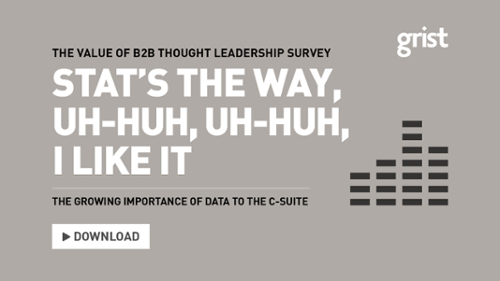Often when companies create thought leadership, or any type of content really, the default is to present the company’s view. Even in today’s client-centric world it’s still “here’s OUR version of events; this is what WE make of this market trend; this is what OUR experts think is on the horizon”.
But while that might stroke internal egos and make the sales team happy, does it really move the needle in terms of thought leadership? And does it give your clients – the ones you’re hoping to attract by creating thought leadership – the information they need and seek?
If we pause and consider what thought leadership truly is, we’ll see the noise of today’s content marketplace is mainly just that: noise. A good definition of thought leadership is Elise Bauer’s (a blogger for the likes of Symantec and Apple): Thought leadership is the recognition from the outside world that a company deeply understands its business, the needs of its clients, and the broader marketplace in which it operates.
So why do companies keep looking at thought leadership from the inside, rather than the outside?
Views of clients, not company experts, the most sought-after
To look into what it is that the typical B2B client wanted from thought leadership, we launched the Value of Thought Leadership Survey, and we have just released our latest report for 2019. At recent roundtable sessions in London, we gave a select group of seasoned B2B marketers an early peek into the latest findings.
The views of companies were not high on the list of either our respondents or those in the room. Most senior people want to hear the views of their clients/customers (62%) – those who will ultimately use their goods or services. This is something PwC did well with its Citizens’ Jury, brought together to help inform its thought leadership programme on the future of financial services.
About half of our respondents want to hear from their peers to find out how they are tackling the issue in question, and 44% want to hear from industry experts. If those experts are from your company, you best make sure they are true market influencers and not just your nominated spokesperson of the day.
Said one roundtable attendee: “Most people treat thought leadership as an internal thing. They rope in an expert from a law firm or IT firm and badge that as expertise. Maybe we should talk to clients more, but there is a lot of reluctance. Those clients might say something they don’t know or don’t want to hear - then the company might have to change something! Companies want to be seen as the experts. There’s a perception if we go and talk to actual clients we’ll get ‘found out’.”
Related blog: Three ways to bring your B2B clients into the content creation process
What makes an expert?
With that reluctance to step away from the company perspective, our roundtable attendees noted that particularly in the realm of professional services, “we often think we’re the experts”. According to our survey, one in three of the C-suite in professional services want to hear from advisory firms, so the question of “whose views” does come down to the industry you are in. If you’re an advisory firm in tax compliance, turns out the C-suite does want to hear from your internal experts. If you’re an office space provider, it’s more likely to be your end clients’ views or those outside the industry that are sought.
Experts come in all shapes and sizes, though, and 41% of survey respondents want to hear from inspirational individuals from outside their industry. They want to get that outside perspective, to get away from the industry silo and learn lessons that could be brought over. Professional services firm TMF Group does this by working with mountaineer Sir Ranulph Fiennes and former football referee Pierluigi Collina as brand ambassadors, giving clients an outsider’s perspective on “scaling new heights” and “playing by the rules”.
Speaking of silos, our roundtable attendees wondered why marketers focus so much on CEOs and decision-makers in our thought leadership, especially in B2B. Yes, these are the ultimate end user for your products and services, but we often forget there are levels underneath that decision-maker who can and do influence them. These are the people the C-suite seeks advice and opinion, and if you’re not addressing them in your thought leadership then you are “missing a trick”, said one attendee.
Those marketing communications professionals who build a content programme around getting perspectives from outside the industry, keeping the client or end user in mind and remembering that thought leadership is not just thinly veiled sales material, often turn out to be the leaders. It’s these perspectives that make for more interesting dialogue – and that help elevate thought leadership from guff to great.
For more insights, download the full report: The Value of Thought Leadership: The Growing Importance of Data.



